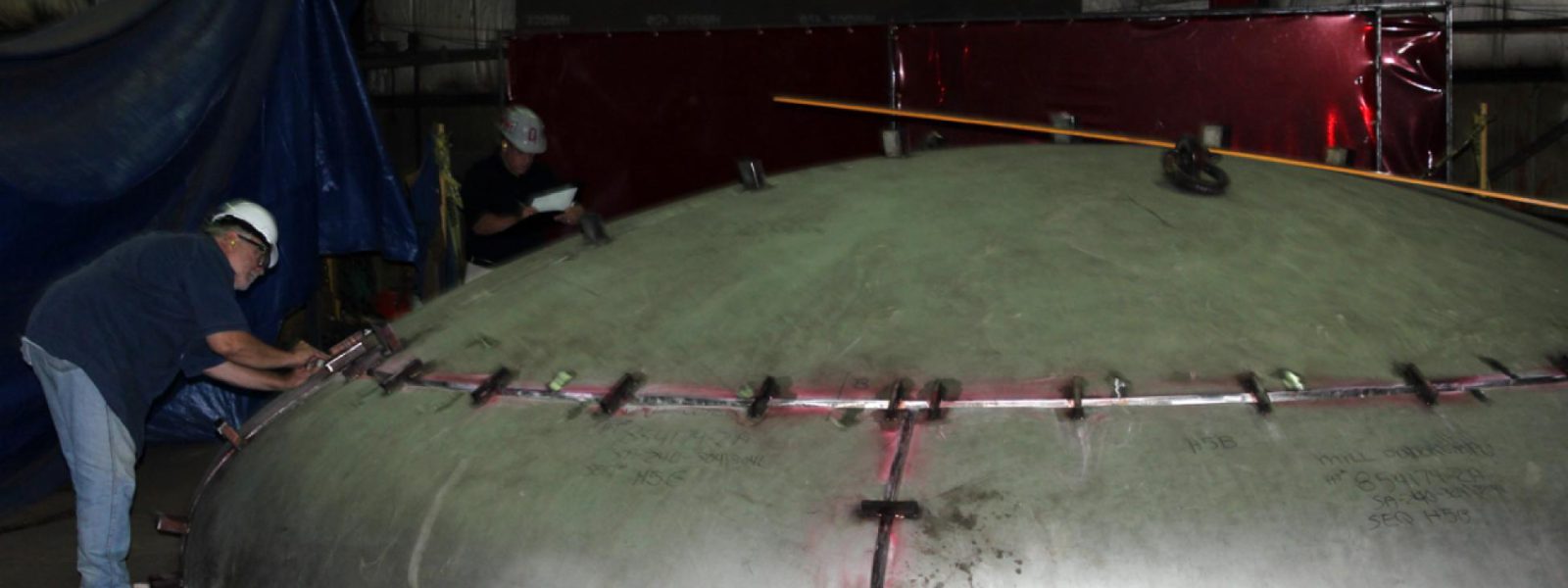―Katie Elyce Jones
Drain tank fabrication for ITER’s tokamak cooling water system is progressing steadily under the leadership of US ITER, which is managed by Oak Ridge National Laboratory for the U.S. Department of Energy. The drain tanks will be among first major hardware items shipped to the ITER site, now under construction in France. The US production timing will accommodate the installation sequence for the ITER fusion facility.
Joseph Oat Corporation, a sub-contractor to AREVA Federal Services and based in Camden, New Jersey, has begun fabrication activities for four 31-foot-tall 78-metric ton drain tanks and one 17-foot-tall 46-metric ton drain tank. Another industry partner, ODOM Industries in Milford, Ohio, is fabricating the ten tank heads as a sub-contractor to Joseph Oat Corporation.
ODOM will ship each tank head as it is fabricated, and will complete delivery to Joseph Oat Corporation by the end of 2013. Joseph Oat, which specializes in industrial fabrication of pressure vessels and heat exchange technologies, expects to stagger completion of drain tanks throughout the summer and fall of 2014.
“Because the tanks are so large, the ITER Organization will install the tanks one at a time and do so before the neighboring building is constructed,” Chris Beatty, US ITER tokamak cooling water systems engineer said.
Beatty noted that a hot cell building will permanently block access to the drain tanks in the tokamak complex once the ITER facility is complete. The tanks, which are built to last 40 years, are expected to perform beyond the duration of the ITER project.
The tokamak cooling water system includes over 20 miles of piping in an intricate network that wraps around the ITER tokamak, a doughnut-shaped machine where a deuterium-tritium reaction will generate 500 megawatts of fusion power. The primary cooling water system is responsible for transferring heat from tokamak hardware to the secondary cooling system. The tokamak cooling water system also supports operations such as baking of in-vessel components, chemical control of water provided to client systems, and draining and drying for maintenance.
“There are many ways to cool a reactor, but ITER uses water to cool the internal parts,” said Juan Ferrada, US ITER tokamak cooling water senior systems engineer and technical project officer.
When the water isn’t being used for operations, such as cooling the system through the network of pipes, it can be stored in four large drain tanks that hold up to 63,000 gallons of water each. Two 78-ton tanks are reserved for normal maintenance and operations. During maintenance, the smaller, 46-ton tank will store coolant for the neutral beam injector that pelts high-energy atoms into the tokamak to heat the plasma.
The other two 78-ton tanks, known as the safety drain tanks, are primarily used for storage in case water should leak into the vacuum vessel. Because fusion reactions use tritium and the plasma-facing wall is made of beryllium, the safety tanks are designed to hold water with radioactive particles such as dust, tritium and activated corrosion products.
The pressurized, stainless steel drain tanks must meet French regulations, giving these US fabricators the opportunity to gain experience implementing French regulations for nuclear pressure equipment.
“Compliance with French nuclear pressure equipment regulations is new to most manufacturers in the US,” said Glen Cowart, US ITER quality assurance specialist. “In addition, tank fabrication must meet the ITER Organization’s requirements as well as engineering and quality criteria established by AREVA Federal Services and US ITER.”

“We have to make sure our design criteria meet the French regulations so the tanks can be used for ITER nuclear operations in France,” Beatty said.
Following approved designs, the tanks are being fabricated out of stainless steel plates. Typical plates are 9 feet wide and 32.7 feet long, with each plate weighing over 8.5 tons. The design requires that each tank have two hemispherical heads—comprised of a curved top cap and a base, fabricated from 6 segments (called petals), that are welded together. Joseph Oat has begun beveling and welding the plates, and rolling them into a cylindrical shape. The caps and base will then be welded to the cylindrical body to form the approximately 20-foot-diameter tanks.
Although the drain tanks are simple equipment from an engineering standpoint when compared to many parts of ITER, their sheer size and weight, in addition to being the first set of US ITER- provided equipment fabricated under the French nuclear regulatory framework, make the fabrication and delivery process extremely demanding.
“Even moving the plates is time consuming,” Beatty said. “It takes about an hour to move them from the beveling machine to where they will be welded. Once they’re welded, the plates are even larger (approximately 65 feet x 18 feet x 1 inch, and 18 tons) so it can take half a day just to flip them over.”
Once the tanks are completed, approved for nuclear pressure safety, and delivered to the ITER site in France, they will pose one more challenge: Positioning the heavy tanks inside the tokamak complex. To meet this challenge, plans are already in place for using specialized air pads to maneuver the tanks to their permanent home in the ITER facility.
Media Contact: Lynne Degitz
